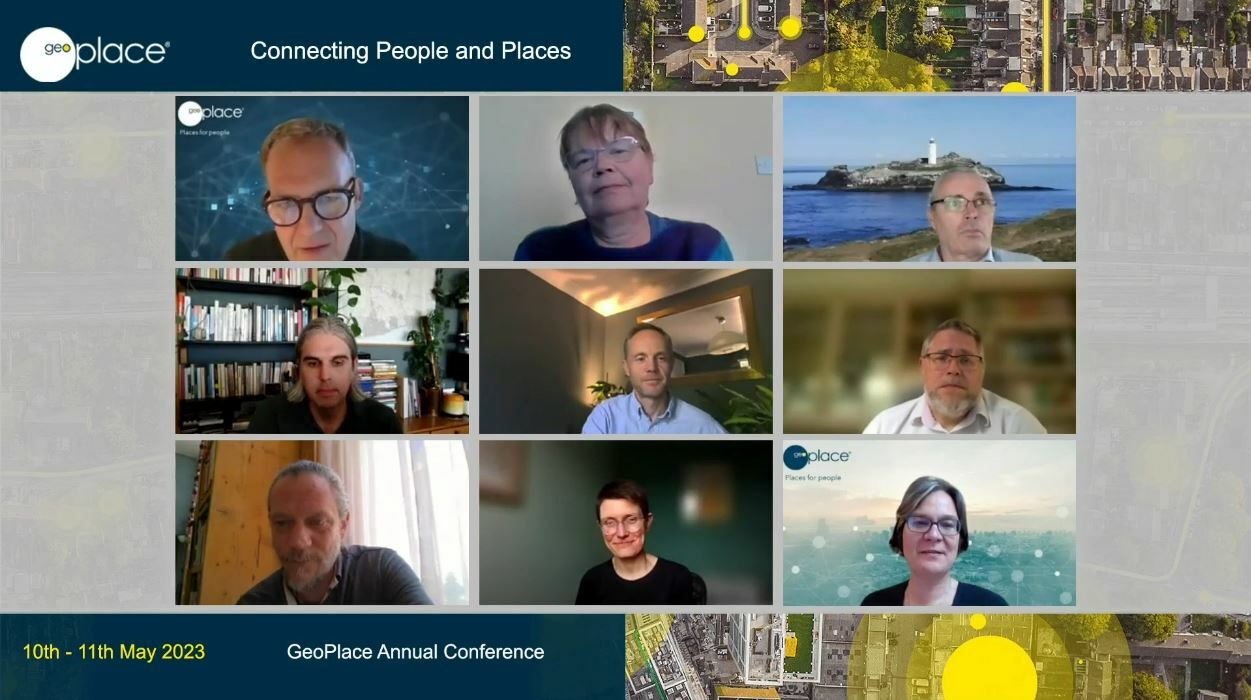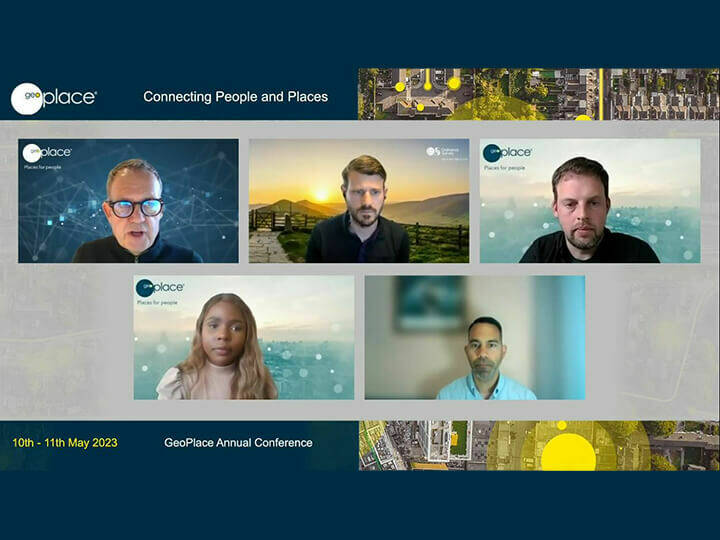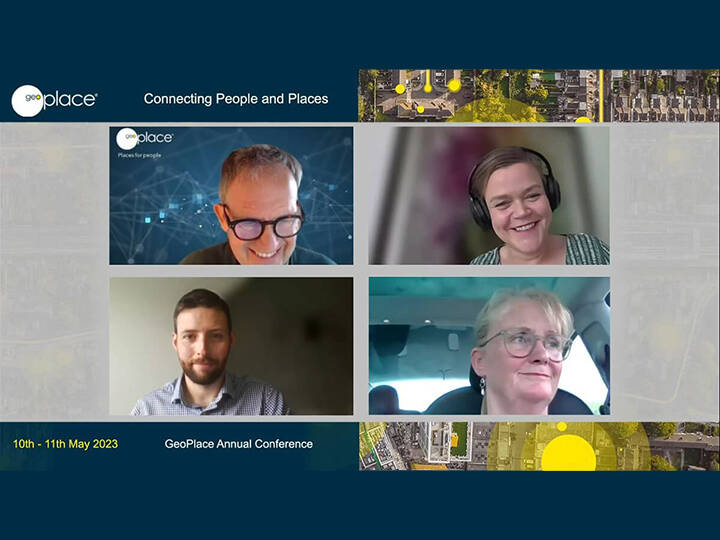The final session at the GeoPlace conference on day 2 looked ahead to the coming year, with reflections and predictions from the Principal Chairs of local authority address and street groups, and members of GeoPlace.
SPEAKERS:
Cathy Coelho, (Principal Chair of the DCA Regional Address Group)
Kerry Pearce, (National Address Data Manager)
Keith Curran, (Principal Chair of the DCA Regional Streets Group)
Jonathan Bates, (National Street Manager), GeoPlace
Simon Barlow, Executive Director of Consultancy, GeoPlace
Simon Bailey, Senior Strategic Relationship Manager, GeoPlace

Watch talks from the session on the 11th May tab on the agenda
The year ahead from the Principal Chairs
Cathy Coelho, (Principal Chair of the DCA Regional Address Group) and Kerry Pearce, (National Address Data Manager) covered the main areas of focus this year as an overview. At the beginning of the year, for example, around 7,300 organisation names were reported as being inconsistent. But by the end of the year, this had been reduced to just 250 – Custodians are keeping pace with real time changes. In addition, over 99.9% of problems with coordinates have been resolved, which is an outstanding achievement, as is a similar level of achievement with tertiary residential classifications.
Cathy went on to explain the role of ACE (Authority Contacts Executive), which is the contract management team for the DCA; two local authority elected representatives meet with two GeoPlace representatives on a regular monthly basis – balancing the needs of external / internal users and creating authorities/Custodians.
Keith Curran then updated the conference on improvement schedules during 2022/23, and Jonathan Bates ran through the level of data quality improvements. Over 47,000 Street Health Check 1 & 2 errors have been fixed, ensuring higher levels of accuracy for all. With regard to road classification work (R199b), 12,126 records have been reviewed. 1,150 km of the NSG has been updated, which is a notable and significant increase on the reliability of road classifications in the NSG. Jon continued, noting that for the first time, GeoPlace has been able to quantify the number of changes authorities are making on the NSG, Over 8 million changes were made during the 22/23 year. This coincides with the launch of DataVIA and the changing ways in which users can now consume the NSG.
Keith provided an update on the uptake of FindMyStreet. Since its launch in March 2021, the service has had more than four million queries, with two million in the last 11 months. This exceeds the expectations, but perfectly demonstrates the appetite for authoritative data. He continued, noting that the release of the new NRSWA Codes of Practice emphasises the importance of the NSG but also challenges for local highway authorities.

The year ahead from GeoPlace
Simon Barlow opened the session with a reflection on themes and trends, and a look at the potential impact of Street and Address data in the future. The excellent news is that, along with the data being available under the PGSA, location data is gaining more recognition as a vital resource for the UK’s resilience. GeoPlace’s case studies provide strong insights into the potential use cases. There seems to be less conversation around the maintenance of location data for specific purposes, and more dialogue around innovation and non-siloed approaches. The recent launch of an application on gov.uk for registering tall buildings, for example, shows how the UPRN is now at the heart of national data infrastructure. Linked to that, during this conference, many examples have been presented showing how siloes are being broken down and how addressing information is making a positive difference to the population. Simon continued, reflecting on the number of organisations that have developed independent strategies for location data, and of the many times national gazetteers are now being incorporated into internal data portfolios. The conversation is now less around ‘why’ OS AddressBase or UPRNs should be adopted, and far more geared towards ‘how’.
Many in the industry have come to the realisation that address and street data is fundamental to positive impacts on both public and private sector services. Examples include the transformation of the insurance industry, as it moves away from postcodes and embraces addressing at individual property levels; and the use of UPRNs in identifying vulnerable persons, for health and welfare.
GeoPlace is making a difference by working alongside myriad partners, listening to customers and driving even more value into and from location data. A significant part of this work focuses on helping PSGA members to achieve high quality adoption and integration of the data into systems, services and user journeys. But it also includes ensuring that GeoPlace and Ordnance Survey continue to deliver the data that customers need. This means actively responding to consultations, white papers, and RFIs, and championing the data itself as well as the role of Custodians. It has been hugely beneficial to cluster this activity around themes this year: overlapping areas that includes the use of property data in government, in the mitigation of fraud, and in support of vulnerable people. This is an approach that will be taken forward into 2024.
Simon Bailey continued with a perspective on the future use of street data. He surmised that the general principles to deliver best practice in use of street data have gained traction over the last 12 months: the use of authoritative data and registers, the adoption of ‘collect once’ policies leading to multiple instances, the collection and use of contextual reference data, and the importance of ensuring interoperability. Several strong themes have also emerged. These include health, the transport revolution, technology, the environment, the economy, and data interoperability itself – and these have overlaps, too.
The transport revolution, for example, is changing the way location data is perceived and used. In 2019, there were 97,000 electric vehicle charging points, but by 2023 that had increased to more than 760,000 with the addition of 490,000 hybrids having a further impact on use of fossil fuel stations. The subsequent changes to network use and transport culture is impacting all kinds of service provision. In the process, charging models are still developing and multi-use streets are coming under the spotlight. Planning considerations will continue to change, as electric vehicles continue to grow in popularity. The working-from-home culture has also had an impact on the transport network over the last couple of years, and street and address data is fundamental to understanding how best to optimise products and services in that vein. The street network is evolving.
As another example, Simon looked at the impact of streets (data and works) on the economy in general. He cited a much better understanding of highway assets recently, and how they work in combination and can be maintained more effectively. This leads to opportunities to explore new and alternative funding models. Simon also briefly touched on the impact of streets for health and welfare over the last few years. ‘Healthier streets’ is a concept that’s delivering positive outcomes for citizens across the UK, with everything from improvements of road surfaces to the increase of street trees in urban areas. Over £2 billion has been invested in Active Travel England, for example. £200 million is being contributed to route improvements and a further £32.9 million is being invested to create a national network of walking and cycling. Scotland and Wales are also making great progress in this regard. In addition, this links in to the ‘Road to Net Zero’ project, being championed by HAUC(UK). This initiative looks at ways in which the streetworks and roadworks can reduce its impact on the net carbon emissions being contributed across the UK.
Technology raises challenges but also presents huge opportunities. These include dynamic routing and parking, trenchless technologies and pipe robots – ways of working that reduce the impact on citizens, reduce carbon emissions, and mitigate risk. The use of Artificial Intelligence is increasing, and is certain to have an impact on streets.
Simon concluded by looking briefly at interoperability. He reflected on the need for improvements in the use of change intelligence, and touched on the increasing use of APIs and multi-flow data, which is improving the efficiency and effectiveness of location data implementation.



